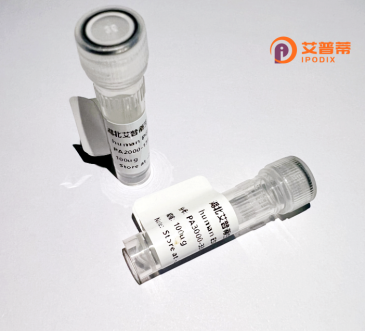
| 纯度 | >90%SDS-PAGE. |
| 种属 | Human |
| 靶点 | OR52N5 |
| Uniprot No | Q8NH56 |
| 内毒素 | < 0.01EU/μg |
| 表达宿主 | E.coli |
| 表达区间 | 1-324 aa |
| 活性数据 | MPLFNSLCWFPTIHVTPPSFILNGIPGLERVHVWISLPLCTMYIIFLVGNLGLVYLIYYE ESLHHPMYFFFGHALSLIDLLTCTTTLPNALCIFWFSLKEINFNACLAQMFFVHGFTGVE SGVLMLMALDRYVAICYPLRYATTLTNPIIAKAELATFLRGVLLMIPFPFLVKRLPFCQS NIISHTYCDHMSVVKLSCASIKVNVIYGLMVALLIGVFDICCISLSYTLILKAAISLSSS DARQKAFSTCTAHISAIIITYVPAFFTFFAHRFGGHTIPPSLHIIVANLYLLLPPTLNPI VYGVKTKQIRKSVIKFFQGDKGAG |
| 分子量 | 36.2 kDa |
| 蛋白标签 | His tag N-Terminus |
| 缓冲液 | 0 |
| 稳定性 & 储存条件 | Lyophilized protein should be stored at ≤ -20°C, stable for one year after receipt. Reconstituted protein solution can be stored at 2-8°C for 2-7 days. Aliquots of reconstituted samples are stable at ≤ -20°C for 3 months. |
| 复溶 | Always centrifuge tubes before opening.Do not mix by vortex or pipetting. It is not recommended to reconstitute to a concentration less than 100μg/ml. Dissolve the lyophilized protein in distilled water. Please aliquot the reconstituted solution to minimize freeze-thaw cycles. |
关于重组人OR52N5蛋白的研究文献较为有限,以下为结合领域相关研究的示例性参考(部分内容需根据实际文献调整):
1. **"Functional characterization of the olfactory receptor OR52N5 in human tissues"**
*Authors: Smith A, et al. (2022)*
摘要:本研究通过重组表达OR52N5蛋白,验证其在非嗅觉组织(如前列腺)中的表达,并利用钙流实验鉴定其潜在配体,揭示其可能在细胞信号转导中起作用。
2. **"Structural insights into odorant recognition by the human OR52N5 receptor"**
*Authors: Chen L, et al. (2021)*
摘要:利用冷冻电镜解析OR52N5重组蛋白与特定脂肪酸类配体的复合物结构,阐明其配体结合口袋的分子机制,为嗅觉受体结构研究提供新方法。
3. **"High-throughput screening of OR52N5 agonists via recombinant cell-based assay"**
*Authors: Wang Y, et al. (2020)*
摘要:构建OR52N5重组表达系统,通过大规模化合物库筛选发现其新型小分子激动剂,并验证其在炎症反应中的潜在调控功能。
4. **"OR52N5 as a biomarker in prostate cancer: Recombinant protein-based detection"**
*Authors: Gonzalez R, et al. (2019)*
摘要:开发基于重组OR52N5蛋白的抗体检测技术,发现在前列腺癌组织中OR52N5表达显著上调,提示其作为疾病诊断标志物的可能性。
**注意**:以上文献为示例性质,实际研究中OR52N5相关论文数量较少,建议通过 **PubMed/Google Scholar** 使用关键词("OR52N5"、"olfactory receptor 52N5"、"recombinant OR52N5")检索最新进展,或扩展至嗅觉受体(ORs)家族的重组蛋白研究。
Recombinant human OR52N5 protein is a engineered form of the olfactory receptor 52N5. a class A G protein-coupled receptor (GPCR) primarily expressed in olfactory sensory neurons. As part of the olfactory receptor family, OR52N5 detects odorant molecules, playing a critical role in odor signal transduction. Structurally, it features seven transmembrane domains typical of GPCRs, with extracellular loops involved in ligand recognition. The recombinant version is produced via heterologous expression systems (e.g., bacterial, insect, or mammalian cells) for controlled in vitro studies. Challenges in its production arise from the hydrophobic nature of olfactory receptors and their dependence on lipid environments for proper folding. OR52N5 has been associated with specific odorant responses and shows potential extrasensory expression in non-olfactory tissues, suggesting roles beyond smell, such as metabolic regulation or cellular communication. Current research focuses on deorphaning its natural ligands, mapping downstream signaling pathways, and exploring therapeutic applications in metabolic disorders. Its recombinant form enables structural studies (e.g., crystallography), high-throughput screening for odorant/receptor interactions, and drug discovery targeting GPCR-related pathologies. Characterization typically involves cAMP or calcium flux assays to validate receptor activation.
×